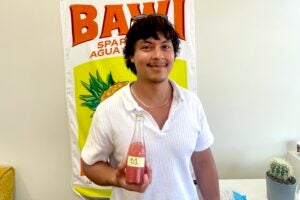AUSTIN, Texas—The University of Texas at Austin Marine Science Institute (UTMSI) in Port Aransas, Texas, has reported the first natural indoor spawning of cobia, a species of saltwater fish popular with recreational fishermen and considered highly promising in aquaculture. In Texas, the fish are referred to as ling.
Proof that cobia will spawn naturally in indoor tanks opens the door to raising the fish for food, or for restocking wild populations, should they become depleted. The cobia’s hardiness, rapid growth rate and flesh quality make it an ideal candidate for aquaculture, while recreational fishermen prize it as a combative catch.
Cobia can reach more than 100 pounds in weight, six feet in length and usually are dark brown
with lighter side stripes. They are distributed worldwide in tropical, subtropical and warm temperate salt water. They are considered low in level of abundance.
Collecting and coordinating the maturation of a sexually mature male and female fish has been a challenge because the two genders appear identical, but may travel in segregated groups in the wild. Cobia are large and aggressive feeders, making it a challenge to hold and spawn them in captivity.
UTMSI’s Fisheries and Mariculture Laboratory obtained approximately 500,000 fertilized cobia eggs from the spawn, which have been divided between UTMSI and the Texas Parks and Wildlife Department. The seven broodstock fish, ranging in size from 15 pounds to 30 pounds, were captured beginning in summer 1999 and kept in a 9,000-gallon recirculating aquaculture system.
Cobia have been grown successfully in outdoor cages in the protected areas of bays in Taiwan for food, but yields there are subject to the weather and the seasons.
"When cobia are spawned in an outdoor pond, egg production is less controlled or consistent throughout the year," said Jeff Kaiser, UTMSI research scientist assistant working on the project. "By having a spawning population indoors, we can simulate the seasons in a controlled fashion using light and temperature manipulations. This process can result can be multiple spawning throughout the year.
"The cobia larvae are larger than many of the fish we have worked with, suggesting that production and survival of fingerlings on a large scale can be achieved," said Kaiser.
The UTMSI research team, led by Dr. Connie Arnold, associate director, and Dr. Joan Holt, senior research scientist, has been capturing and raising cobia since 1989.
For more information, contact Dr. Joan Holt in Port Aransas at (361) 749-6716, or e-mail <joan@utmsi.utexas.edu>, or see <www.utmsi.utexas.edu/staff/gjholt> or contact Caroline Ladhani at (512) 232-1075. For images, see: <www.utexas.edu/admin/opa/news/01newsreleases/nr_200105/cobia2.html>.



